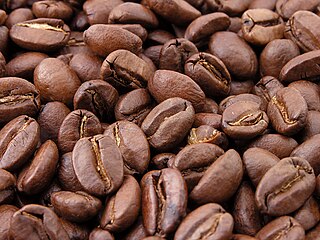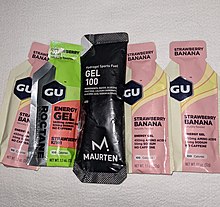
Red Bull is a brand of energy drinks created and owned by the Austrian company Red Bull GmbH. With a market share of 43%, it is the most popular energy drink brand as of 2020, and the third most valuable soft drink brand, behind Coca-Cola and Pepsi. Sinсe its launch in 1987, more than 100 billion cans of Red Bull have been sold worldwide, including over 12 billion in 2023.

Chocolate milk is a type of flavoured milk made by mixing cocoa solids with milk. It is a food pairing in which the milk's mouthfeel masks the dietary fibres of the cocoa solids.

Gatorade is an American brand of sports-themed beverage and food products, built around its signature line of sports drinks. Gatorade is currently manufactured by PepsiCo and is distributed in over 80 countries. The beverage was first developed in 1965 by a team of researchers led by Dr. Robert Cade. It was originally made for the Gators at the University of Florida to replenish the carbohydrates that the school's student-athletes burned and the combination of water and electrolytes that they lost in sweat during vigorous sports activities.

Sports drinks, also known as electrolyte drinks, are functional beverages whose stated purpose is to help athletes replace water, electrolytes, and energy before, during and especially after training or competition. The evidence is lacking pertaining to the efficacy of use of commercial sports drinks for sports and fitness performance.

Carbohydrate loading, commonly referred to as carb-loading, or carbo-loading, is a strategy used by endurance athletes, such as marathoners and triathletes, to maximize the storage of glycogen in the muscles and liver.

An energy drink is a type of drink containing stimulant compounds, usually caffeine, which is marketed as providing mental and physical stimulation. They may or may not be carbonated and may also contain sugar, other sweeteners, or herbal extracts, among numerous other possible ingredients.

Energy bars are supplemental bars containing cereals, micronutrients, and flavor ingredients intended to supply quick food energy. Because most energy bars contain added protein, carbohydrates, dietary fiber, and other nutrients, they may be marketed as functional foods. Manufacturing of energy bars may supply nutrients in sufficient quantity to be used as meal replacements.

Maltodextrin is a name shared by two different families of chemicals. Both families are glucose polymers, but have little chemical or nutritional similarity.

Milo is a chocolate-flavoured malted powder product produced by Nestlé, typically mixed with milk, hot water, or both, to produce a beverage. It was originally developed in Australia by Thomas Mayne (1901–1995) in 1934.

Crystal Light is an American brand of powdered and artificially sweetened beverage mixes produced by Kraft Heinz. It was introduced in 1982 to a test market and released to the public in April 1984. General Foods, a now defunct company, were the original sellers of the product, but now it is sold by Kraft Foods. It is available in a wide variety of flavors, such as lemonade, sweet tea, and fruit punch.

Sparks was an alcoholic beverage that debuted in the US market in 2002. The original formulation contained caffeine, one of the first alcoholic beverages to do so. Its other original active ingredients included taurine, ginseng and guarana, common to energy drinks.
Bodybuilding supplements are dietary supplements commonly used by those involved in bodybuilding, weightlifting, mixed martial arts, and athletics for the purpose of facilitating an increase in lean body mass. Bodybuilding supplements may contain ingredients that are advertised to increase a person's muscle, body weight, athletic performance, and decrease a person's percent body fat for desired muscle definition. Among the most widely used are high protein drinks, pre-workout blends, branched-chain amino acids (BCAA), glutamine, arginine, essential fatty acids, creatine, HMB, whey protein, ZMA, and weight loss products. Supplements are sold either as single ingredient preparations or in the form of "stacks" – proprietary blends of various supplements marketed as offering synergistic advantages.

The nutrition facts label is a label required on most packaged food in many countries, showing what nutrients and other ingredients are in the food. Labels are usually based on official nutritional rating systems. Most countries also release overall nutrition guides for general educational purposes. In some cases, the guides are based on different dietary targets for various nutrients than the labels on specific foods.

Sports nutrition is the study and practice of nutrition and diet with regards to improving anyone's athletic performance. Nutrition is an important part of many sports training regimens, being popular in strength sports and endurance sports. Sports nutrition focuses its studies on the type, as well as the quantity of fluids and food taken by an athlete. In addition, it deals with the consumption of nutrients such as vitamins, minerals, supplements and organic substances that include carbohydrates, proteins and fats.

Protein bars are a convenience food that contains a high proportion of protein relative to carbohydrates and fats. Despite the label focusing on protein, many mass-marketed protein bars contain more added sugar than some desserts like cookies or doughnuts.
Runa LLC is a privately held organic Amazonian beverage company that processes and sells guayusa. The company is based in Brooklyn, New York, with offices in Quito and Archidona, Ecuador. It was founded in 2008 by two Brown University graduates, Daniel MacCombie and Tyler Gage. The company operates the world's only guayusa processing facility, which is located in Archidona.

GU Energy Labs is a company based in Berkeley, California, that produces sports nutrition products, most notably energy gels. Often consumed during endurance events, the gels are designed to be quickly and easily digested during any type of activity. Other products include energy chews, drink mixes, hydration tablets, stroopwafels and a Roctane line that includes an energy drink mix, protein recovery drink mix, gel, and capsules. The company was founded in 1994 by Bill Vaughan, who began creating an energy gel product in 1990. GU is considered the first major distributor of energy gels. The company has grown over time, and in 2011 its corporate headquarters and 50 employees relocated to a larger space in Berkeley's 4th Street shopping district.
High performance sport dogs are those bred and trained to compete in various athletic events. Events include but are not limited to, agility trials, hunting and racing. These events are physically and metabolically demanding. As a result, canine athletes require specialized nutrition in order to perform at high levels during events and for maintenance and recovery. The main nutritional concern for sport dogs is adequate energy. A well-balanced diet, containing the appropriate amounts of protein, fat, carbohydrate, fiber and micronutrients is essential to meet these energy requirements.
Pre-workout is a generic term for a range of bodybuilding supplement products used by athletes and weightlifters to enhance athletic performance. Supplements are taken to increase endurance, energy, and focus during a workout. Pre-workout supplements contain a variety of ingredients such as caffeine and creatine, differing by capsule or powder products. The first pre-workout product entered the market in 1982, and since then the category has grown in use. Some pre-workout products contain ingredients linked to adverse effects. Although these products are not regulated, the Food and Drug Administration (FDA) warns consumers to be cautious when consuming them.

Caffeine use for sport is a worldwide known and tested idea. Many athletes use caffeine as a legal performance enhancer, as the benefits it provides, both physically and cognitively outweigh the disadvantages. The benefits caffeine provides influences the performance of both endurance athletes and anaerobic athletes. Caffeine has been proven to be effective in enhancing performance.
















